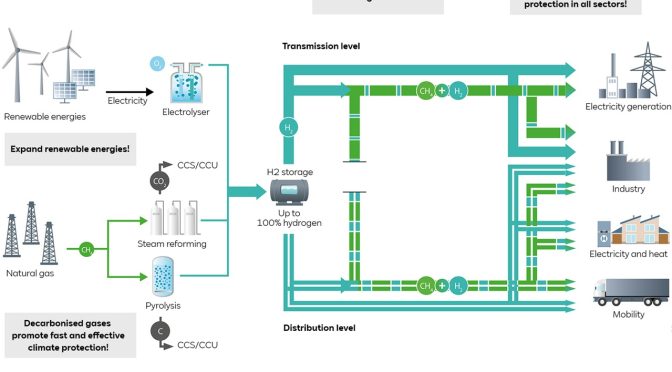Hydrogen – How exactly does this fuel of the future work?
Hydrogen is a naturally occurring chemical element that can be found in almost unlimited quantities. It is 14 times lighter than air, can be combusted without producing any CO2 emissions and is not self-ignitious, corrosive or radioactive. In order to use its energy content, however, this colourless and odourless gas has to be separated off from hydrogen-rich compounds such as natural gas, biomass or water by using chemical, electrical, thermal or solar energy. Water electrolysis involves using electricity to break water down into oxygen and hydrogen. A system of colours indicates both the production method as well as its carbon footprint: If the electricity produced by water electrolysis is sourced from renewables, such as wind or solar power, it is referred to as green hydrogen. Grey hydrogen is produced conventionally using natural gas. If the carbon emissions produced in the process are not released but captured and stored, it is referred to as blue hydrogen. Less common is turquoise hydrogen, which entails thermal separation of methane, creating solid carbon rather than climate-damaging carbon dioxide. https://www.youtube.com/embed/hlSf6AX213I?controls=0&modestbranding=1&rel=0&showinfo=0&loop=0&fs=0&hl=en&enablejsapi=1&origin=https%3A%2F%2Fwww.rwe.com&widgetid=1
RWE is paving the way for green hydrogen
Hydrogen is seen as playing a key role in the decarbonisation of energy-intensive sectors. In addition to reducing CO2 emissions in industrial processes, hydrogen could be used as a sustainable fuel in the transport sector and as a sustainable combustible for heat supply in the medium term. The ever increasing interlinking of potential applications – electricity and heat, transport and industry – is referred to as sector coupling.
Green hydrogen in particular is a key technology in the drive for climate neutrality. There are good reasons for this:
- No emissions in generation and application
- Safe to transport, store and handle
- Can be used flexibly either as a fuel or raw material and mixed with natural gas subject to defined limits
- Serves as the basis for producing e-fuels, particularly for cars, aircraft and ships
- Low land use, widely accepted in society
RWE is currently working at full speed on 30 green hydrogen projects together with partners. The positioning of the company along the entire value chain offers ideal conditions for the expansion of a functioning hydrogen infrastructure. In onshore and offshore windpower, in the development of generation facilities for green hydrogen and in the operation of large-scale gas-fired power stations. Thus, RWE has extensive expertise and experience in developing hydrogen all over Europe. This includes participation in projects such as GET H2, NortH2 and AquaVentus. Find out more here.
Rules make hydrogen green
Green hydrogen is indispensable for the energy transition and climate neutrality. The prerequisite for qualifying as “green” is that the hydrogen is produced with the help of renewable sources.
The European Union lays down uniform rules for this, but they still have to be finalised in a special legal text.
Our video explains what is needed for Europe to quickly build the much-needed hydrogen economy.
Discover RWE hydrogen projects
Hydrogen project GET H2 Nukleus RWE partner project at the Lingen site AquaVentus Hydrogen production with electricity from offshore wind farms in the North Sea H2 Brunsbüttel RWE Supply & Trading explores hydrogen imports via LNG terminals South Wales Industrial Cluster Consortium of companies pursues decarbonisation of industry Eemshydrogen Electrolyser with direct connection to onshore wind farm in the Netherlands Rostock Sector coupling project with green hydrogen from the Baltic Sea FUREC Project to use waste stream for hydrogen production HySupply Exploration of a German-Australian hydrogen partnership NortH2 Developing a centre for green hydrogen for north-western Europe
Offshore-to-X
BASF and RWE want to cooperate on new technologies for climate protection. The declaration of intent of both companies focuses on a CO2-neutral chemical industry and green hydrogen. Green electricity and innovative production technology could transform the Ludwigshafen chemical site into a lighthouse project for climate protection in chemical industry. From 2030, an additional offshore wind farm with a capacity of 2 gigawatt is to provide BASF green electricity for CO2-free production processes.
Schematic illustration of BDEW




